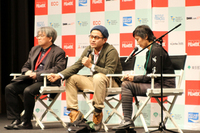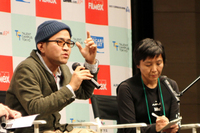 New information will be added. New information will be added.


『祭の馬』松林要樹監督Q&A
from デイリーニュース2013 2013/11/25
 第14回東京フィルメックスの3日目となる11月25日、有楽町朝日ホールにてコンペティション部門の『祭の馬』が上映され、松林要樹監督が上映後のQ&Aに登壇した。アムステルダム国際ドキュメンタリー映画祭から帰国したばかりの松林監督は、現地での反応を交えて、挨拶と共に本作の撮影に至った経緯を語った。 第14回東京フィルメックスの3日目となる11月25日、有楽町朝日ホールにてコンペティション部門の『祭の馬』が上映され、松林要樹監督が上映後のQ&Aに登壇した。アムステルダム国際ドキュメンタリー映画祭から帰国したばかりの松林監督は、現地での反応を交えて、挨拶と共に本作の撮影に至った経緯を語った。
2011年の東日本大震災の2週間後に、支援物資輸送のために友人と福島県南相馬市に入ったという松林監督。1頭の馬がたどった数奇な運命を追ったドキュメンタリーである本作は、この時に撮影がスタートした。「牧場主の田中さんと馬を見かけた時は、何も出来ずにただ撮影するしかありませんでした。しかし、数日後に再度田中さんから、撮影していた中にいた2頭が死んでしまったことを伺い、本当はエサを与えるだけでも出来たのではないか?と考えたことが制作のきっかけだった」。
馬たちの避難所となった相馬馬事公苑では、人手不足が深刻で松林監督自身もエサやりや厩舎の掃除などにボランティアとして参加。馬がどんな生き物なのかを知る過程で、世話をすれば全身で喜びを表現する馬の姿に魅了されていったという。この点については、アムステルダム・ドキュメンタリー映画祭でも質問がされたと松林監督。「作品の前半と後半で作り方が違うのはなぜか?と訊かれましたが、前半は自分のジャーナリスティックな部分の表れ、後半は馬の動きだけに注目している」と語った。
 続いて、会場との質疑応答へ。「厩舎の取材中に撮影しないで欲しいというニュアンスのやり取りがあったがその意図は何だったのか?」という質問には「とても良い質問をありがとうございます」と応じ「当時、自衛隊の駐屯地があり、そこで一般人が出入りをしてカメラを回すのはよくないだろう...というあくまで仮定の懸念が原因」と明かし、「当初は(牧場主の)田中さんも取材を受けることを好んではいませんでしたが、早い段階で現地に入っていたことや、馬の世話を通じ、一員として扱って貰えたことが大きい」と語った。また、昨今の政治状況から「こうしたドキュメンタリーが今後も作ることが出来るのか、日本は非常に厳しい現状を迎えている」と懸念も示した。 続いて、会場との質疑応答へ。「厩舎の取材中に撮影しないで欲しいというニュアンスのやり取りがあったがその意図は何だったのか?」という質問には「とても良い質問をありがとうございます」と応じ「当時、自衛隊の駐屯地があり、そこで一般人が出入りをしてカメラを回すのはよくないだろう...というあくまで仮定の懸念が原因」と明かし、「当初は(牧場主の)田中さんも取材を受けることを好んではいませんでしたが、早い段階で現地に入っていたことや、馬の世話を通じ、一員として扱って貰えたことが大きい」と語った。また、昨今の政治状況から「こうしたドキュメンタリーが今後も作ることが出来るのか、日本は非常に厳しい現状を迎えている」と懸念も示した。
作品に登場した馬たちは、実は相馬野馬追の主要な行事である宵乗り(競馬)や神旗争奪戦には参加しておらず、本編でその説明部分をカットした理由として監督は、「人間と馬との関係を改めて見直すためのシーンにしたかった」と語った。また、映画のラストで象徴的に登場するイメージについては「動物と人間の違いを表現した上で、人間がそれらを思い通りに扱えると錯覚しているのではないか、と問いかけたかった」。
 続いて、特にクレジットに流れていた音楽が印象的だったという感想が寄せられると、10数年前のウイグル旅行の際に聴いた音楽を起用した、と監督。その理由について「ウイグルには中国の核実験場があり、そのイメージと本作が結びついた。歌詞には、故郷の水と山の風景が美しいとあり、馬と人が暮らす地域に核実験場がある現実の皮肉を表現したかった」と語った。 続いて、特にクレジットに流れていた音楽が印象的だったという感想が寄せられると、10数年前のウイグル旅行の際に聴いた音楽を起用した、と監督。その理由について「ウイグルには中国の核実験場があり、そのイメージと本作が結びついた。歌詞には、故郷の水と山の風景が美しいとあり、馬と人が暮らす地域に核実験場がある現実の皮肉を表現したかった」と語った。
次に、アムステルダム国際ドキュメンタリー映画祭での反響については、「あなたが馬の性器に対するこだわりは、文化の違いのせい?」と真面目に質問されたエピソードを交え、「猫が最後までこの映画を観ていたことがあり、モンタージュのやり方と言うのは普遍的なものだと感じた」と松林監督ならではのユニークなコメントで締め括った。
本作は、12月14日(土)より渋谷のシアター・イメージフォーラムでの公開が決定している。また、前日の13日には河出書房新社より、松林監督自身が本作の裏側を綴った『馬喰』が発売される。
(取材・文:阿部由美子、撮影:村田まゆ)
  


|





